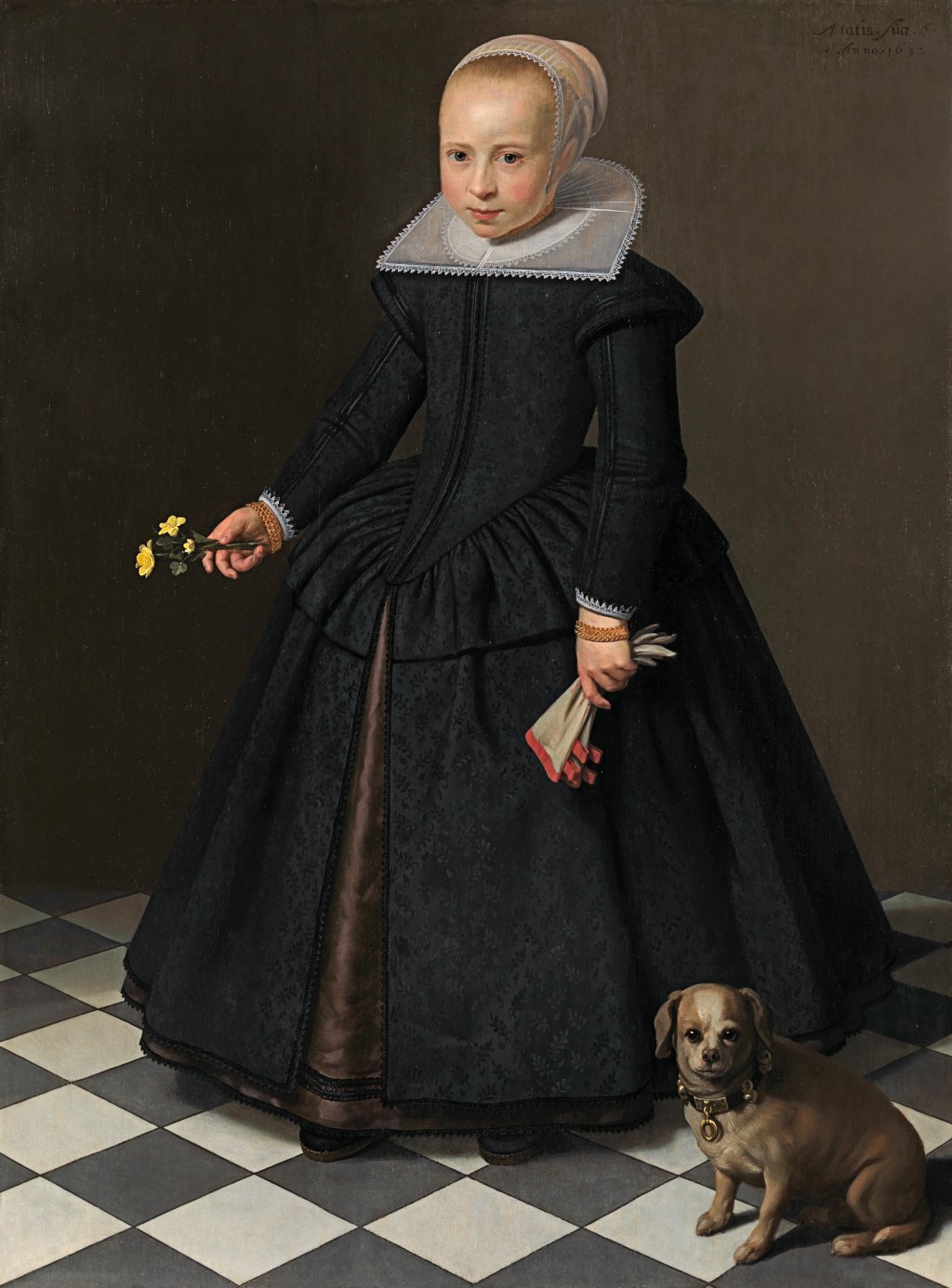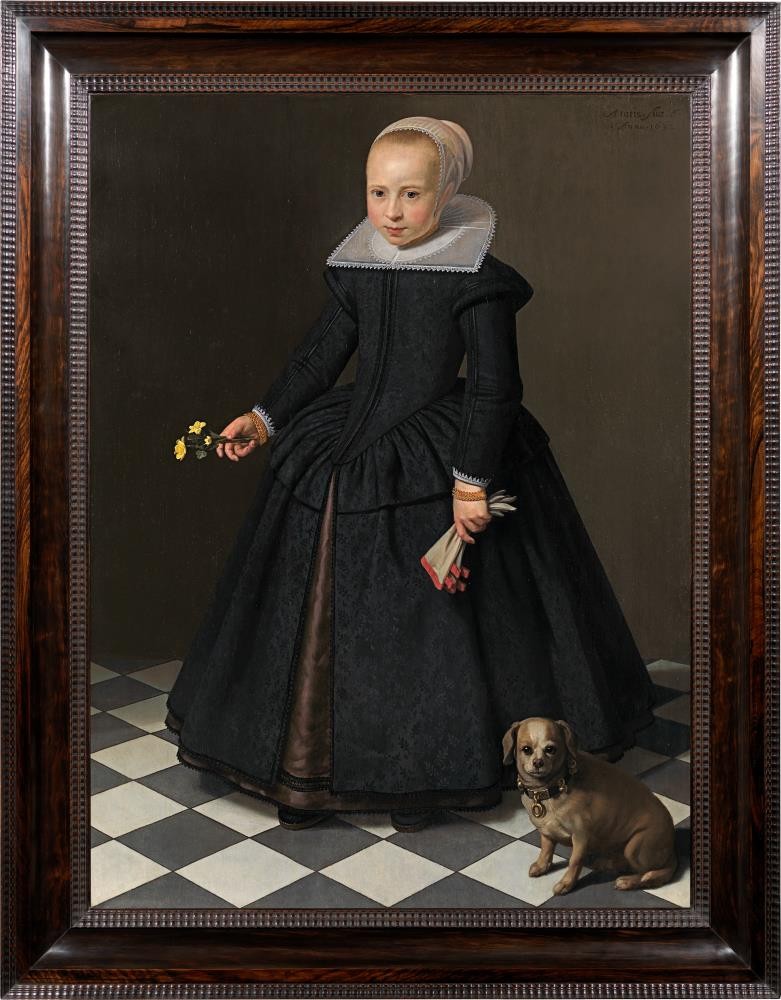DIRCK SANTVOORT
1610 – Amsterdam – 1680
Ref: BY 187
Portrait of a young girl holding buttercups, with her dog beside her
Inscribed and dated upper right: Aetatis. Sua.6 / Anno . 1632
Oil on panel: 45 x 33 ¾ in / 114.3 x 85.7 cm
Frame size: 53 ½ x 42 ¼ in / 135.9 x 107.3 cm
In a black and brown Dutch seventeenth century style ripple frame
Provenance:
Private collection, Europe
Richard Green, London, 1979;
private collection, UK
This portrait was made when Santvoort was only twenty-two, a mere fourteen years older than his sitter. It is his earliest known dated portrait of a child, a type of sitter which he made something of a speciality. Within the context of a formal portrait, Santvoort captures the little girl’s solemn, questing intelligence as well as her flawless, pearly complexion and fine blonde hair. She is both the repository of her family’s dynastic hopes and a delightful, well-loved individual.
Child portraiture was popular in the seventeenth century Netherlands, both among the aristocracy and the high bourgeoisie who impelled the economic powerhouse of Amsterdam, where Santvoort spent all his career. Despite – and because of – high infant mortality, children were treasured for themselves and as symbols of the future. Boys were trained up to inherit businesses. Girls formed marriage alliances which brought wealth and made family networks all the stronger.
As Rudi Ekkart has commented, ‘Santvoort’s most striking gift was his ability to portray children, where his gifts of precise observation and his uncluttered style produced some delightful results’[1]. Here the little girl is set against a plain grey background, standing on a black-and-white chequered stone floor. She wears the restrained, dark clothing fashionable in the northern Netherlands in the first decades of the seventeenth century. The fashion for wearing black was originally linked to Spanish influence when the whole of the Netherlands was under Spanish Habsburg control. Among northern Netherlandish Protestants, it signified a rejection of showiness which reflected the purity and piety of the soul within. Within these constraints, the high status of the child is obvious. Her gown of black – an expensive dye in itself - is of fine, figured material with a brown satin underskirt. Her collar and close-fitting cap are edged with exquisite lace and she wears triple-banded gold bracelets on both wrists.
The dark colours of the girl’s costume are offset by a pair of costly pale kid gloves, edged with coral ribbon, and by the buttercups which she holds in her right hand. Buttercups symbolize her unmarried state, while gloves were often given as betrothal presents. It is possible that this painting was made to mark a betrothal, not for an imminent marriage, but the promise of an alliance when the girl had reached her mid-teens. The dog, as well as being a charming companion for a child, is a symbol of fidelity. Upper class children were expected to teach good behaviour to their pets, as well as to submit themselves to adult instruction and conduct themselves always in a seemly and gracious manner.
DIRCK DIRCKSZ. SANTVOORT
1610 – Amsterdam – 1680
Dirck Santvoort was born in Amsterdam into a family of painters. He was the son of Dirck Pietersz. Bontepaert (1578-1642), grandson of Pieter Pietersz. and the great-grandson of Pieter Aertsen (1508-1575), famous for his genre and religious scenes often featuring kitchen still lifes. Dirck probably studied with his father, whose work no longer survives.
Dirck specialized in portrait painting, both single portraits of adults and groups such as The governesses and wardresses of the Spinhuis, 1638 (Amsterdam Museum). He was the leading painter of children in Amsterdam towards the middle of the seventeenth century. His first known dated child portrait is the 1632 Portrait of a young girl holding buttercups, with her dog beside her (Richard Green Gallery, London). The last dated works that can be firmly attributed to him are from 1645. Santvoort seems to have become wealthy and largely ceased painting, although he remained active in the painters’ guild[2]. He was its Dean in 1658 and was still acting as an assessor of paintings in 1678. Santvoort married twice, the first time in 1641 to Baertjen Pont, with whom he had a son named Rembrandt in 1648, and secondly in 1657 to Tryntje Riewerts (d.1689). He died in Amsterdam in 1680.
Santvoort was superb at capturing both the radiant complexion of a child and their air of questioning innocence. Earlier works such as the portrait of the thirty-month-old Willem van Loon, 1636 (Museum van Loon, Amsterdam) are formal and precise, with exquisite attention to the black and white costume. His portraits of Martinus Alewijn and his sister Clara Alewijn, both of 1644 (Rijksmuseum, Amsterdam) are full of colour and reflect a sophisticated handling of the fashionable pastoral portrait style.
The work of Dirck Santvoort is represented in the Rijksmuseum, Amsterdam; the Amsterdam Museum; the Six Collection, Amsterdam; the Museum van Loon, Amsterdam; the Frans Hals Museum, Haarlem; the Museum Boijmans-van Beuningen, Rotterdam; the Suermondt-Ludwig-Museum, Aachen; the National Gallery, London; the Musée Fabre, Montpellier; the Museum of Fine Arts, Boston and Cleveland Museum of Art.
[1] ‘Santvoort, Dirck’, The Dictionary of Art, London 1996, vol. 27, p.805.
[2] See Haarlem, Frans Hals Museum/Antwerp, Koninklijk Museum voor Schone Kunsten, Pride and Joy: Children’s Portraits in the Netherlands 1500-1700, 2000-2001, exh. cat. by Jan Baptist Bedaux and Rudi Ekkart, p.158.















